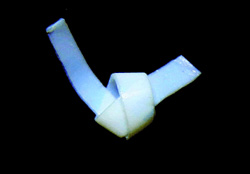Nothing but Air

Delicate and translucent as a puff of air, yet mechanically stable, flexible, and possessing amazing heat-insulation properties—these are the properties of a new aerogel made of cellulose and silica gel. Researchers led by Jie Cai have introduced this novel material, which consists almost completely of air, in the journal Angewandte Chemie.
Gels are familiar to us in forms like Jell-O or hair gel. A gel is a loose molecular network that holds liquids within its cavities. Unlike a sponge, it is not possible to squeeze the liquid out of a gel. An aerogel is a gel that holds air instead of a liquid. For example, aerogels made from silicon dioxide may consist of 99.98 % air-filled pores. This type of material is nearly as light as air and is translucent like solidified smoke.
In addition, it is not flammable and is a very good insulator—even at high temperatures. One prominent application for aerogels was the insulation used on space shuttles. Because of their extremely high inner surface area, aerogels are also potential supports for catalysts or pharmaceuticals. Silica-based aerogels are also nontoxic and environmentally friendly.
One drawback, however, has limited the broader application of these airy materials: silica-based aerogels are very fragile, and thus require some reinforcement. In addition to reinforcement with synthetic polymers, biocompatible materials like cellulose are also under consideration.
The researchers at Wuhan University (China) and the University of Tokyo (Japan) have now developed a special composite aerogel from cellulose and silicon dioxide. They begin by producing a cellulose gel from an alkaline urea solution. This causes the cellulose to dissolve, and to regenerate to form a nanofibrillar gel. The cellulose gel then acts as a scaffold for the silica gel prepared by a standard sol–gel process, in which a dissolved organosilicate precursor is cross-linked, gelled, and deposited onto the cellulose nanofibers. The resulting liquid-containing composite gel is then dried with supercritical carbon dioxide to make an aerogel.
The novel composite aerogel demonstrates an interesting combination of advantageous properties: mechanical stability, flexibility, very low thermal conductivity, semitransparency, and biocompatibility. If required, the cellulose part can be removed through combustion, leaving behind a silicon dioxide aerogel. The researchers are optimistic: “Our new method could be a starting point for the synthesis of many new porous materials with superior properties, because it is simple and the properties of the resulting aerogels can be varied widely.”
About the Author
Dr Jie Cai is an Associate Professor in the College of Chemistry and Molecular Sciences of Wuhan University. His research interests are in biomacromolecules with particular emphasis on cellulose and chitin materials and composites.
Author: Jie Cai, Wuhan University (China), http://www.polyphys.whu.edu.cn/zhanglab-E/sub-staff.htm
Title: Cellulose–Silica Nanocomposite Aerogels by In Situ Formation of Silica in Cellulose Gel
Angewandte Chemie International Edition, Permalink to the article: http://dx.doi.org/10.1002/anie.201105730
Media Contact
All latest news from the category: Life Sciences and Chemistry
Articles and reports from the Life Sciences and chemistry area deal with applied and basic research into modern biology, chemistry and human medicine.
Valuable information can be found on a range of life sciences fields including bacteriology, biochemistry, bionics, bioinformatics, biophysics, biotechnology, genetics, geobotany, human biology, marine biology, microbiology, molecular biology, cellular biology, zoology, bioinorganic chemistry, microchemistry and environmental chemistry.
Newest articles

A universal framework for spatial biology
SpatialData is a freely accessible tool to unify and integrate data from different omics technologies accounting for spatial information, which can provide holistic insights into health and disease. Biological processes…

How complex biological processes arise
A $20 million grant from the U.S. National Science Foundation (NSF) will support the establishment and operation of the National Synthesis Center for Emergence in the Molecular and Cellular Sciences (NCEMS) at…

Airborne single-photon lidar system achieves high-resolution 3D imaging
Compact, low-power system opens doors for photon-efficient drone and satellite-based environmental monitoring and mapping. Researchers have developed a compact and lightweight single-photon airborne lidar system that can acquire high-resolution 3D…





















